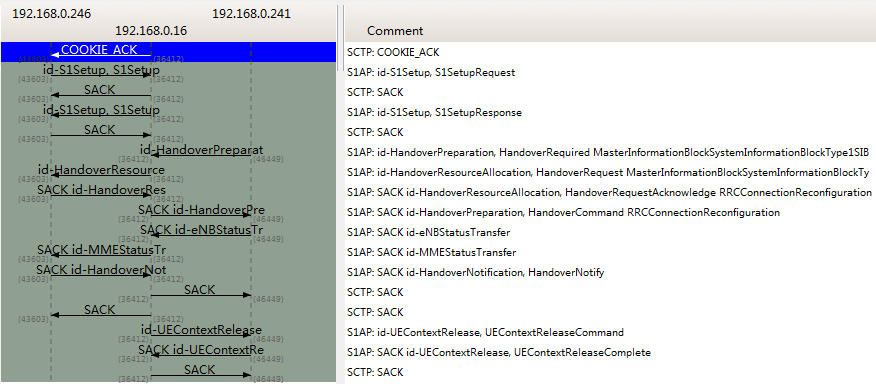In brief, eNodeB select one MME based on IE:
Relative MME Capacity in S1 Setup Response,
S-GW and P-GW were selected by MME,
S-GW is selected based on TAI in S1AP message and P-GW is selected based on APN information
Purpose
In telecommunications there may be different reasons why a handover might be conducted:
- when the phone is moving away from the area covered by one cell and entering the area covered by another cell the call is transferred to the second cell in order to avoid call termination when the phone gets outside the range of the first cell;
- when the capacity for connecting new calls of a given cell is used up and an existing or new call from a phone, which is located in an area overlapped by another cell, is transferred to that cell in order to free-up some capacity in the first cell for other users, who can only be connected to that cell;
- in non-CDMA networks when the channel used by the phone becomes interfered by another phone using the same channel in a different cell, the call is transferred to a different channel in the same cell or to a different channel in another cell in order to avoid the interference;
- again in non-CDMA networks when the user behaviour changes, e.g. when a fast-travelling user, connected to a large, umbrella-type of cell, stops then the call may be transferred to a smaller macro cell or even to a micro cell in order to free capacity on the umbrella cell for other fast-traveling users and to reduce the potential interference to other cells or users (this works in reverse too, when a user is detected to be moving faster than a certain threshold, the call can be transferred to a larger umbrella-type of cell in order to minimize the frequency of the handovers due to this movement);
- in CDMA networks a handover (see further down) may be induced in order to reduce the interference to a smaller neighboring cell due to the "" effect even when the phone still has an excellent connection to its current cell;
- etc.
The most basic form of handover is when a in progress is redirected from its current (called source) to a new cell (called target). In terrestrial networks the source and the target cells may be served from two different cell sites or from one and the same cell site (in the latter case the two cells are usually referred to as two sectors on that cell site). Such a handover, in which the source and the target are different cells (even if they are on the same cell site) is called inter-cell handover. The purpose of inter-cell handover is to maintain the call as the subscriber is moving out of the area covered by the source cell and entering the area of the target cell.
A special case is possible, in which the source and the target are one and the same cell and only the used channel is changed during the handover. Such a handover, in which the cell is not changed, is called intra-cell handover. The purpose of intra-cell handover is to change one channel, which may be interfered or fading with a new clearer or less fading channel.
219 327.012056000 192.168.0.241 192.168.0.16 S1AP 338 id-HandoverPreparation, HandoverRequired MasterInformationBlock SystemInformationBlock Type1SIB2
221 327.090744000 192.168.0.16 192.168.0.246 S1AP 394 id-HandoverResourceAllocation, HandoverRequest MasterInformationBlock SystemInformationBlock Type1SIB2
223 327.107316000 192.168.0.246 192.168.0.16 S1AP 250 SACK id-HandoverResourceAllocation, HandoverRequestAcknowledge RRCConnectionReconfiguration
225 327.130743000 192.168.0.16 192.168.0.241 S1AP 246 SACK id-HandoverPreparation, HandoverCommand RRCConnectionReconfiguration
226 327.136987000 192.168.0.241 192.168.0.16 S1AP 122 SACK id-eNBStatusTransfer
227 327.150732000 192.168.0.16 192.168.0.246 S1AP 122 SACK id-MMEStatusTransfer
229 327.188326000 192.168.0.246 192.168.0.16 S1AP 122 SACK id-HandoverNotification, HandoverNotify
SIG_DFL, SIG_IGN //sigaction - examine and change signal action
| #define SIG_DFL /*implementation defined*/ | ||
| #define SIG_IGN /*implementation defined*/ |
The SIG_DFL and SIG_IGN macros expand into integral expressions that are not equal to an address of any function. The macros define signal handling strategies for () function.
| Constant | Explanation |
SIG_DFL | default signal handling |
SIG_IGN | signal is ignored |
| S.N. | Macro & Description |
|---|---|
| 1 | This macro initializes ap variable to be used with the va_arg and va_end macros. The last_arg is the last known fixed argument being passed to the function ie. the argument before the ellipsis. |
| 2 | This macro retrieves the next argument in the paramater list of the function with type type. |
| 3 | This macro allows a function with variable arguments which used the va_start macro to return. If va_end is not called before returning from the function, the result is undefined. |
